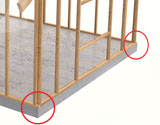Learning to effectively use a handgun for self-defense is hard work, and don’t let anyone tell you otherwise. Although anyone can learn to point the gun in the general direction of an assailant and yank the trigger, there’s a lot more to this discipline than simply being able to make a loud noise when you feel threatened.
First, there’s the process of getting the knowledge you need about the legal aspects of owning, carrying, and using a deadly weapon. None of this stuff is intuitive. The rules for owning and carrying guns are different in different jurisdictions, and those rules change all too often. The rules for using the gun to protect yourself tend to be more stable, but that does not make them either simple or intuitive. Getting a good, basic handle on those legal questions takes some effort and some skull sweat. (Incidentally, if you’re not a reader, an excellent place to start your learning process is with the seven DVDs that come free with an ACLDN membership. These DVDs discuss the basic rules of the road for using firearms in self-defense, along with providing clear, compelling discussions of the legal and social aftereffects of using deadly force to protect yourself and your loved ones.)
Then there’s the emotional hard work of sorting out your own beliefs about killing. When do you think it is right to kill another living, breathing, feeling, thinking human being? When is it absolutely wrong? Those are the easy questions. Here’s the hard one: Am I myself able to pull the trigger if that is what it takes to survive? Under what circumstances am I willing to do that? Am I willing to do it if it is a young person, such as a drug-addicted teenager who has lived next door to me since he or she was a small child? Am I willing to do it if it is someone I once cared about, such as a violent ex-boyfriend or ex-husband? Am I absolutely sure I want to go down that road? Am I able to face those choices without flinching or freezing?
After dealing with the legal and emotional/ethical questions, we come to the social issues. What will my mother say about my decision to carry a firearm, if she finds out? How will my friends react, if they find out? Am I willing to deal with the social fallout if my children’s friends’ parents learn that we own and use guns? Thinking through those questions may seem trivial to some people, but many of us have a very difficult time coming to grips with those social concerns.
Then there’s the question of criminal behavior and psychology. Criminals attack their victims in some predictable ways, but it’s emotionally draining to learn about how violent crime happens so we’re better able to avoid it. We do it anyway, because that knowledge helps us stay safe. We need to know how assailants choose their victims. We must study how violent attacks happen and learn how survivors have defended themselves. Along with that, we must begin training ourselves to notice the things going on around us so we can learn how to avoid dangerous situations before they develop. That’s hard work, too.
All of that pales when we think about the sheer physical effort it takes to master the use of a firearm. Again, anyone can pick up a gun and yank the trigger, with the bullet flying who-knows-where. But acquiring the skill to handle the firearm with confidence, understand how it works, understand how to keep it working even if something goes wrong and it doesn’t go bang when we press the trigger – that’s hard. Getting to the point where we can handle the gun with the same casual confidence we feel in the driver’s seat of a car, with the same almost-unconscious ability to manipulate the machine’s controls while thinking about other, more important, things – that’s hard. Learning to hit the target reliably every time, regardless of time or stress constraints – that’s hard. Learning to draw the gun with smooth efficiency, building the good safe habits that will see you through a tough time – that’s hard. Learning how to use cover or concealment while shooting, learning how to move while shooting, learning how to reliably hit your target even if it’s dark, even if you don’t have much time, even if your vision is compromised because your glasses got knocked off – that’s hard.
After we’ve learned those physical skills, we need to maintain them. That’s also hard. Finding the time to practice isn’t easy, and finding a place to practice some of the most important skills can be very challenging indeed. Standing on the range for hours while we develop the skills under the tutoring of a qualified instructor is hard enough, but having the personal discipline to force ourselves to practice the un-fun stuff as much as we practice the fun stuff when there’s no one standing there encouraging us to try it anyway – that’s hard.
Sometimes I talk to people who feel stupid because they don’t understand all of this intuitively, or because they can’t just pick up a gun and use it as effectively as the magical people do on TV, or because they have to struggle to master fundamental gun handling skills. If you’re in that boat, please let me give you a ray of hope here: you’re normal. It’s actually normal to find this stuff hard work. It does not mean there’s something wrong with you. It simply means you are doing the work it takes to learn something challenging.
We do that work because it’s worth it. Being prepared to defend ourselves is worth it. Being able to protect the people we love? Worth it! Having the confidence that makes would-be Trouble take one look at you and head the other direction – totally worth it. Life is precious, and your life is worth defending.






